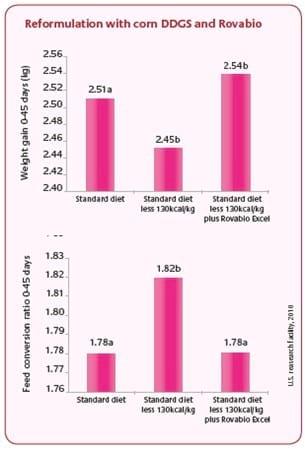Corn DDGS in poultry
Enhance the nutritional value of corn DDGS in poultry
Published: January 10, 2012
By: Don McIntyre, Regional Technical Manager in North America, Adisseo, USA
Today, by-products of ethanol production like corn distillers dried grains with solubles (DDGS) are being used in livestock feeds. Largely due to economics and availability, we have seen more DDGS fed each year for the past three years. Research studies have investigated DDGS inclusion rates up to 40% of finishing diets and most have settled within a range of 5-15% inclusion rate to commercial flocks. In the early days of ethanol production, we faced much variation in DDGS product quality as plants were built and procedures were developed. Now, we are challenged with additional variation as DDGS are produced from different corn varieties, using new technologies and more recently by additional fat removal from original by-products. So, where does this leave us on a practical basis? Sometimes serendipity is a wonderful consequence. To be certain, during the development of Rovabio® more than 15 years ago no one could have foreseen current energy costs in North America, corn prices and DDGS use. Nevertheless, it is the multi-enzyme nature of Rovabio® that positions this product as the ideal NSP enzyme for new ingredients like DDGS. Further, with its cellulase component, Rovabio® has proven additional efficacy on diets containing DDGS and basically increases the nutritional value of corn DDGS.

Note that cellulose is actually increased by three fold in DDGS compared to corn. Therefore, inclusion of corn DDGS at 15% in the diet increases the cellulose and the arabinoxylans contents by 30 and 20% respectively. If not considered, this can adversely effect growth performance. In August 2010, a pen trial with Rovabio® Excel LC was concluded at Southern Poultry Research Inc. in Athens, Ga. The diets fed were comprised of corn, soybean meal, DDGS and poultry fat, exclusive of any animal protein source. DDGS contributed 12% of the diets. The three treatments (noted in the charts below) were a Positive Control, a Negative Control (Positive Control less 130kcal/kg) and a Negative Control plus Rovabio® Excel LC. At the conclusion of the study it was determined that Rovabio® birds performed equally as well as the Positive Control birds and exhibited statistically significant improvements in weight gain and feed conversion versus the Negative Control birds. The combined improvements calculate to 3.5% gains in Adjusted Feed Conversion Ratios for the Rovabio® treatments. Feed cost savings for the Rovabio® diets were more than $10.00 per ton versus the Positive Control diets.
We consider that Rovabio® safely uplifts the energy content of corn DDGS by 5.5% as demonstrated by in vitro and in vivo trials.
Related topics:
Authors:
Diamond V
Recommend
Comment
Share
Recommend
Reply

Would you like to discuss another topic? Create a new post to engage with experts in the community.








